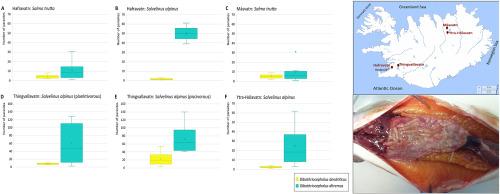Occurrence and the first molecular genotyping of Dibothriocephalus dendriticus and Dibothriocephalus ditremus (Cestoda: Diphyllobothriidea) in salmonids from Iceland
IF 1.7
Q3 PARASITOLOGY
Current research in parasitology & vector-borne diseases
Pub Date : 2025-01-01
DOI:10.1016/j.crpvbd.2025.100301
引用次数: 0
Abstract
The occurrence of Dibothriocephalus dendriticus and Dibothriocephalus ditremus (Cestoda: Diphyllobothriidea) in salmonids from lakes Hafravatn, Thingvallavatn, Másvatn, and Ytra-Hólavatn in Iceland was studied. The exact taxonomic identification of plerocercoids was performed by a recently validated molecular discriminatory PCR-based approach using D. dendriticus-specific Dd_8 primers. Of 1684 plerocercoids isolated from 58 fish (40 Arctic charrs Salvelinus alpinus, and 18 brown trout Salmo trutta), 318 (18.9%) larvae were identified as D. dendriticus and 1366 (81.1%) as D. ditremus. The prevalence of D. ditremus was high at all four localities, ranging from 54.2% to 100%. Similarly, the prevalence of D. dendriticus ranged from 50.0% to 100% in all lakes, except for Ytra-Hólavatn, where a prevalence of 14.3% was recorded. All examined specimens of large benthivorous (LB) charr from Thingvallavatn were negative, which was related to the specific habitat and the different feeding specialization of the LB morph. In contrast, the prevalence and the intensity of infection with both D. dendriticus and D. ditremus were high in piscivorous and planktivorous Arctic charr morphs. The intensity of infection with D. dendriticus was lower in all four lakes compared to much higher values detected for D. ditremus. The relative abundance of D. dendriticus and D. ditremus plerocercoids in individual fish hosts showed substantially lower values for D. dendriticus in all four lakes. This can be explained by various climatic conditions required for egg development and by the different feeding ecology of aquatic birds, definitive hosts of both tapeworms.

冰岛鲑科树突状二叉头虱和双叉头虱的发生及首次分子基因分型研究
研究了冰岛Hafravatn湖、Thingvallavatn湖、Másvatn湖和Ytra-Hólavatn湖鲑科鱼类中树突双胸头绦虫(dibothricephalus dendriticus)和双胸头绦虫(Dibothriocephalus ditremus)的发生情况。利用树突状棘球蚴特异性的Dd_8引物,通过最近验证的分子鉴别pcr方法对棘球蚴进行了准确的分类鉴定。从58条鱼(40条北极鲑、18条褐鳟)中分离得到1684条尾尾蚴,其中树突尾蚴318条(18.9%),白鲑尾蚴1366条(81.1%)。4个地区均有较高的白僵鼠流行率,为54.2% ~ 100%。同样,除了Ytra-Hólavatn外,所有湖泊树突菌的患病率为14.3%,其余湖泊树突菌的患病率为50.0% ~ 100%。研究结果表明,大腹食性动物(large benthivorous charr, LB)标本均呈阴性,这与大腹食性动物(large benthivorous charr, LB)的特定栖息地和摄食专门性不同有关。与此相反,在食鱼和浮游的北极鼠中,树突夜蛾和异突夜蛾的感染率和感染强度都很高。4个湖泊中树突夜蛾的感染强度都较低,而白沟夜蛾的感染强度要高得多。在所有四个湖泊中,树状棘球蚴和异鳍棘球蚴在个体鱼宿主中的相对丰度都明显较低。这可以用卵发育所需的各种气候条件和水鸟的不同摄食生态来解释,水鸟是这两种绦虫的最终宿主。
本文章由计算机程序翻译,如有差异,请以英文原文为准。
求助全文
约1分钟内获得全文
求助全文

 求助内容:
求助内容: 应助结果提醒方式:
应助结果提醒方式:


